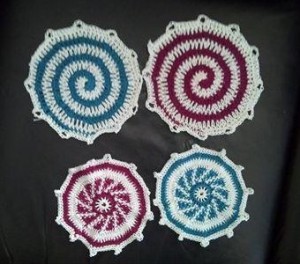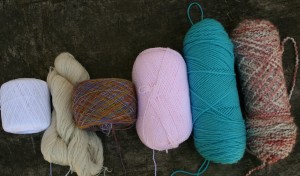 So I have been keeping a secret, not really intentionally, but because I have been caught up in the use of a really great yarn.
So I have been keeping a secret, not really intentionally, but because I have been caught up in the use of a really great yarn.
The yarn fits my climate, it is a cotton rayon blend, so it is great for warm weather, the biggest problem I have with it is figuring out what project to work next with it. I have even worked on projects at knitting and crochet gatherings and had several people go out of their way to ask me what yarn I am using. The yarn you ask, well it is Lotus by Designing Vashti.
I should mention that the yarn was developed and created especially for crocheters by my friends Vashti Braha and Doris Chan, but that has not influenced by words about the yarn. They did not ask me to give a review of the yarn, they do not even know that I am writing this, but I felt that I should let the cat out of the bag about this little secret.

Swatches I worked up in Lotus, as I was playing with circles. The colors, white, teal and grenadine are beautiful!
The yarn is created with a “Z” twist, this means that the yarn is plied in the opposite direction as most yarns that have an “S twist” (basically it is the direction that the threads are spun together). This may not seem like much of a difference, but as a long time crocheter, I can tell you that there have been many yarns that always seem to slip when I use them. I never really thought about it, I just accepted this has the norm. So why did the yarn split? I never really investigated it before, but when you really pay attention to the way the yarn works, I am right handed, and by working yarn overs it actually works the yarn in the opposite it is plied for traditional yarns, removing twist. But Lotus holds up very well, as working a yarn over actually is in the same direction as the twist and firms up the yarn instead of twisting it a part. So that is a bonus, but not my favorite part of the yarn.
This is also the only yarn I can think of that I actually prefer after it is blocked, or washed. It seems to actually get softer and the strand feels like it fluffy up without distorting the stitch, it is quite a perk. It also has a nice gleam to it. It is not so shiny that it feels limited, but it is definitely not dull. It reminds me of an expensive fabric, but a fabric that carries the heavy lifting of everyday wear and is not so delicate that it hides in the closet.
This yarn is only available on-line, but it seems quit to ship and is in my hands impressively fast. There is a vast array of colors that will inspire many ideas. Classic jewel tones and flattering pastels are easily accented with the nice selection of neutrals, including white, grey, pearl, and black. I will admit, the hardest part of ordering for me it choosing which color, so I often left the family make a vote and I have never been disappointed with their choices.
The combination of cotton and rayon, seem to perfectly complement each other and create a fabric that has really nice drape, yet is very breathable in my California weather. It is a fine weight yarn, listed as #2, which is another thing I actually like. Finding a cotton yarn that is smaller than a medium weight or #4, and greater then thread can sometimes be difficult. I find that hand of this yarn very versatile. It has a recommended hook size of F/5-3.75mm or G/7-4.5mm, but I found that I enjoy working it with an H/8-5mm and even at time a J/10-6mm.
If you are feeling like trying something new, check out Lotus yarn, I am sure you will find it as noteworthy as I have.
(If you happen to attending the Knit & Crochet Show, Saturday, July 26, 2014 at Manchester, NH stop by the show floor at 12:30 and try out Lotus at the “Cented Flower” Make & Take demonstration I will be giving).

